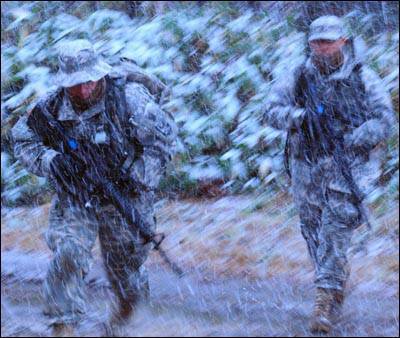American soldiers dressed in heat-sensitive uniforms.
 The complexity of military service is associated with many factors, and one of them is that soldiers are forced to act in various climatic conditions: from the chilling, penetrating cold to the exhausting, sizzling heat, there is an order, and it must be fulfilled. The Pentagon decided in some way to facilitate the service of its servicemen and announced a competition for the development of new universal clothing able to independently adapt to different climatic conditions and provide the necessary coolness in the heat of the sun, warmth in the eerie cold and water-tightness in pouring rain. The new uniform should solve the perennial problem: the need to wear extra clothing on the back in case of a possible whim of an unpredictable nature.
The complexity of military service is associated with many factors, and one of them is that soldiers are forced to act in various climatic conditions: from the chilling, penetrating cold to the exhausting, sizzling heat, there is an order, and it must be fulfilled. The Pentagon decided in some way to facilitate the service of its servicemen and announced a competition for the development of new universal clothing able to independently adapt to different climatic conditions and provide the necessary coolness in the heat of the sun, warmth in the eerie cold and water-tightness in pouring rain. The new uniform should solve the perennial problem: the need to wear extra clothing on the back in case of a possible whim of an unpredictable nature.By 2012, every company that wants to become a supplier of a completely new uniform, you must create a material that can acquire warming properties while lowering the ambient temperature.
In clothes, the order for which is controlled by the research division of the US Land Forces (RDECOM), the soldier must be neither hot nor cold. The operating temperature range should be from + 23 to -40 ˚C. If soldiers descend from high mountains to a valley with air temperatures down to -30 ˚C, smart clothes should quickly adapt to the obvious change in weather conditions and should remain just as comfortable.
In addition, the new material must withstand at least 20 washes, be hypo-allergenic and inert. The prototype does not need to have refractory properties, but the final version should have this characteristic.
Army representatives do not insist on certain technologies. As an example, they call the previously developed method of "bimetallic thermostat". This method involves the integration into the fabric of a large number of paired metal fiber lines. Metals in each pair have different coefficients of thermal expansion. During cooling, one of the metals shrinks more strongly, unlike the other, which is why they fold into a kind of curl and fit more closely to the surface. As a result, the material saves heat better.
Applications from inventors and further potential producers will be accepted until September, and reviewed by commission members in October and November, and by January 2012, RDECOM will select the most suitable options, giving each bidder up to 100 thousand dollars. The winner after the final decision will receive up to 1 million dollars for development.
In the event that the Pentagon’s program ends in success, a new, unique type of clothing will emerge, which may be widely used both in the military and civilian sphere, where such unique qualities of an “all-weather” material are no less in demand.
Information